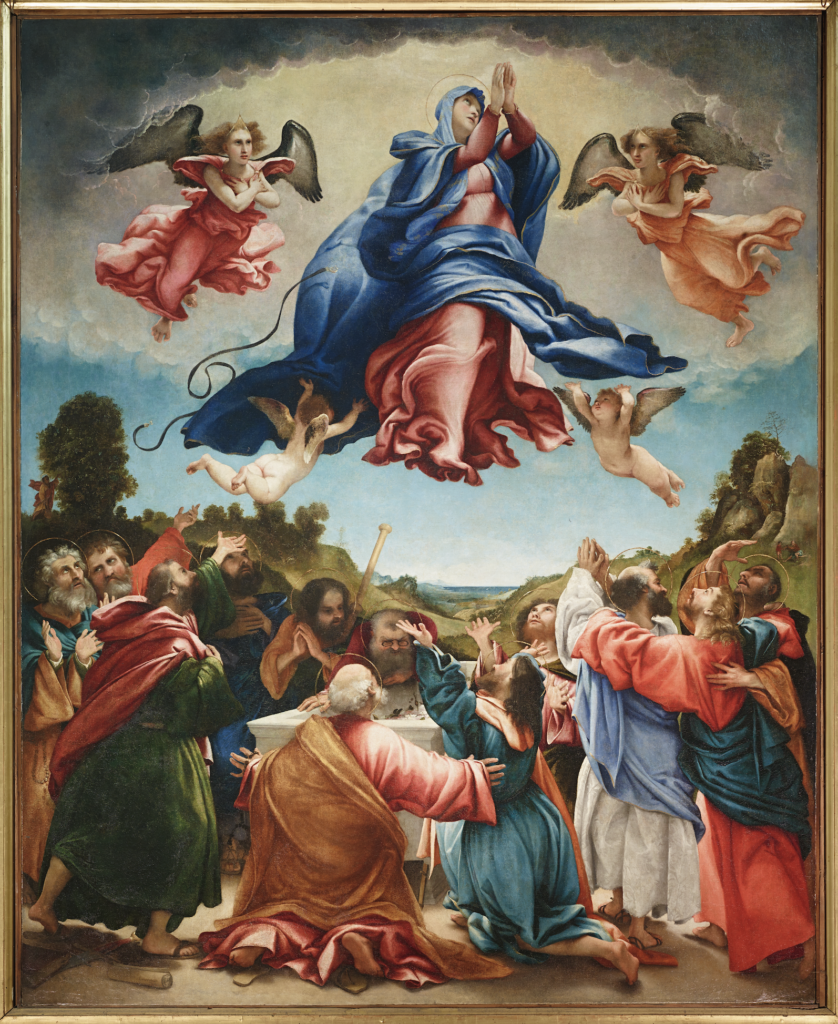Assumption of the Virgin, 1527
oil on canvas, 238 × 193 cm
Celana (Caprino Bergamasco), church of Santa Maria Assunta

At the end of 1525 Lorenzo Lotto returned to Venice, his hometown, and it was there that he painted the Assumption of the Virgin for the parish church of Celana, which was immediately shipped to the Bergamo area; it was probably commissioned by Lotto’s merchant and friend Balsarino Marchetti Angelini from Caprino, already a patron of the painter for the altarpiece of Santo Spirito in Bergamo.
The Assumption is characterized by an intense chromatic search and a highly theatrical composition, by an everyday-like language that manifests itself with particular vigor in some of the apostles’ dismayed expressions and gestures of devotional astonishment: all turned to the central event in the upper part of the painting, Christ’s followers are arranged in a circular form around the Marian tomb, which, emptied of the body, bears inside some roses (flower-symbol of the Virgin Mary) as a testimony to the miraculous event.
The Madonna is taken up into heaven in the excited dynamism of her robes moved by the wind, surrounded by four angels who assist her: particularly important is the visual weight that Lotto gives to the colors of the robes, which take on a starring role in their grandeur thanks to the contrasting tones of the palette (the reds and blues), all played out in the alternation of warm and cold colors.
In the lower register of the painting an additional theatrical charge is given, as mentioned earlier, by the twelve apostles. Some watch in prayerful disbelief at the event, stretching out their joined hands and arms toward the miracle of the Assumption, others gaze in dismay at the tomb left empty: unforgettable among them is the elderly character, with an imposing beard, who leans down wearing pince-nez glasses to view ‘in focus’ the tomb, now left empty. Another detail that testifies to Lorenzo Lotto’s skillful narrative and spirit materializes in the background on the hillside, in the shadow of the tree on the left side: we catch a glimpse of Thomas, the unbelieving apostle who has lingered and to whom the Virgin lets the blue girdle fall back toward him as tangible proof of his assumption.
A classic comparison, most useful for understanding the differences between the social classes of the patrons and the stylistic languages of the two authors, is between Celana’s Assumption and Titian’s Assumption in Santa Maria Gloriosa dei Frari in Venice (1516-1518), one of the greatest masterpieces of 16th-century painting: if Lotto, in works like this one, is the standard bearer of the artistic peripheries, his rival Titian, on the contrary, is the champion of the powerful and the rulers thanks to a pompous and celebratory painting.
The poor state of preservation of the Celana canvas – already recorded in the 19th century, when the painting surface, formerly on panel, was transported to canvas – does not allow us to fully read the signature on the scroll rolled up in the left foreground, which, we know from ancient sources, was “laurentius lotus / [1527 pinxit].”
- Opening time : On reservation
- Telephone +035 781024
- E-Mail: Contact us